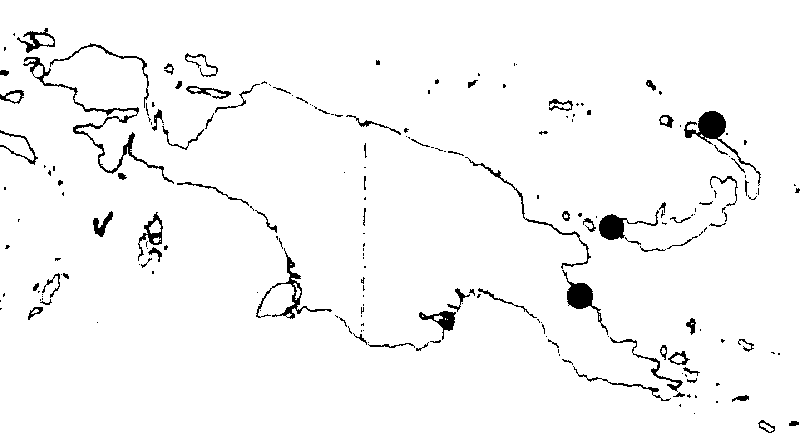
Distribution Map

Description (Barlow 1993)
Decaisnina longipes Barlow, spec. novo
Species nova D. hollrungii (Schumann) Barlow similis, sed foliis ellipticis vel fere orbicularibus vix bifacialibus, pedunculis triadorum longioribus, pedicellis florum lateralium longis, antheris multo longioribus quam partibus filamentorum liberis differt. - Holotypus: Ridsdale NGF 30401 (holo L 148988), Papua New Guinea, Bismarck Archipelago, Western New Britain, Kilenge, 50 25' S 148025' E, c. 200 ft (60 m), 14.xii.1966.
Glabrous. Stems robust; internodes slightly to distinctly angular and dilated towards the apex when young, soon becoming terete, 5-7 cm long. Leaves opposite; lamina elliptic to almost orbicular, 8-:13 cm long, 4.5-9 cm wide, coriaceous, very weakly bifacial with the upper surface slightly darker and dull or slightly glossy, cuneate at the base to a winged petiole 25-40 mm long, usually undulate at the margin, rounded at the apex; venation pennate with the midrib raised below and other venation faintly visible on both sides. Inflorescences axillary, racemes of triads with the central flowers sessile and the lateral flowers pedicellate; axis soon becoming robust, 35-70 mm long, 1.5-3 mm thick, bearing 10-14 pairs of triads distributed along the entire length but tending to be aggregated in false whorls of 4; peduncles of the triads 5-10 rmp long; pedicels of the lateral flowers 1.5-3 mm long; bracts spreading, obtuse or rounded, 1.5-2.5 mm wide and long. Ovary cylindrical, c. 3 mm long; catyx limb erect, truncate or very slightly toothed, 1-1.5 mm long. Corolla in the mature bud slender, 30-50 mm long, shortly rounded at the apex; petals reflexed at anthesis 8-10 mm below the apex, coherent as a slender tube in the lower 2-15 mm. Anther 4-8 mm long; free part of the filament c. 2 mm long. Style slender, gradually narrowed; stigma ellipsoid, slightly wider than the style. Fruit (probably immature) ellipsoid, c. 7 mm long, truncate at the apex and crowned by a style base 0.1-0.2 mm long.
Decaisnina longipes is distributed in northeastern New Guinea and the Bismarck Archipelago (Fig. 2; 4 collections seen), at low elevations from 60 to 700 m. Habitat details are poorly known; one collection is recorded from lowland hill forest, and there are no host records.
The species has few specialized characters, and thus presents a relatively generalized facies for the genus. It shares with D. hollrungii its robust habit, angular young stems, long inflorescences, and long corollas with petals coherent into a short tube. However, it is otherwise quite distinctive, and there may not be a direct relationship between these two species. Decaisnina longipes can be identified by its combination of large rounded leaves slightly bifacial but more or less dull on both sides, petioles more than 25 mm long, long inflorescences with triads on long peduncles and often in loose groups of four, well-developed pedicels of the lateral flowers, petals remaining distinctly coherent in the lower part after anthesis, and long anthers much longer than the free parts of the filaments. The flower colour is recorded as red in the lower part and yellow above.
The two specimens from New Britain were .previously referred to D. djamuensis (Barlow, 1974) which now appears to be restricted to the New Guinean mainland and Biak. Decaisnina longipes differs from D. djamuensis in most of the characters listed above. The specimen from Morobe District, Papua New Guinea, was previously referred to D. triflora (Barlow, 1974). Resolution of these misidentifications has. clarified the circumScription and morphological boundaries of the species concerned, leaving each of them more homogeneous. Decaisnina longipes is presumably a young endemic which has differentiated in situ, probably from an ancestral stock common to other Papuasian species as well (see note under D. hollrungii).
The specific epithet alludes to the long petioles and peduncles of the triads, and particularly to the long pedicels of the lateral flowers of the triads.
Additional specimens examined: Millar NGF
22692 (L, LAB), Papua New Guinea, Morobe,
Garaina, near Sopa, 2300 ft (700 m), 22.vii.1966; Henty &
Frodin NGF 27353 (L, LAE), New Guinea, Bismarck Archipelago,
New Britain, Kandrian, Wariai, 7 mi (11 km) SE of Benim, 50 47'
S 1480 57' E, 1000 ft (300 m), 23.iii. 1966; Croft LAE 65598
(L), New Guinea, Bismarck Archipelago, New Ireland, 5 km S of
Logagon, 2° 57' S 151°21' E, 600 m, 23.x.1974.
Illustrations
Photographs
Decaisnina longipes
updated 19 January 2007